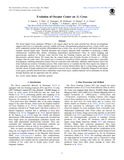| dc.contributor.author | Nathues, A. | |
| dc.contributor.author | Platz, T. | |
| dc.contributor.author | Thangjam, G. | |
| dc.contributor.author | Hoffmann, M. | |
| dc.contributor.author | Mengel, K. | |
| dc.contributor.author | Cloutis, E. A. | |
| dc.contributor.author | Le Corre, L. | |
| dc.contributor.author | Reddy, V. | |
| dc.contributor.author | Kallisch, J. | |
| dc.contributor.author | D. A. Crown, D. A. | |
| dc.date.accessioned | 2018-03-02T19:12:40Z | |
| dc.date.available | 2018-03-02T19:12:40Z | |
| dc.date.issued | 2017-02-17 | |
| dc.identifier.citation | Nathues, A., T. Platz, G. Thangjam, M. Hoffmann, K. Mengel, E.A. Cloutis, L. Le Corre, V. Reddy, J. Kallisch, and D.A. Crown. "Evolution of Occator crater on (1) Ceres." Astronomical Journal, 153 (3) (2017): 112. DOI: 10.3847/1538-3881/153/3/112. | en_US |
| dc.identifier.issn | 0004-6256 | |
| dc.identifier.uri | http://hdl.handle.net/10680/1376 | |
| dc.description.abstract | The dwarf planet Ceres (diameter 939 km) is the largest object in the main asteroid belt. Recent investigations suggest that Ceres is a thermally evolved, volatile-rich body with potential geological activity, a body which was never completely molten but possibly differentiated into a rocky core, an ice-rich mantle, and which may contain remnant internal liquid water. Thermal alteration and exogenic material infall contribute to producing a (dark) carbonaceous chondritic-like surface containing ammoniated phyllosilicates. Here we report imaging and spectroscopic analyses of Occator crater derived from the Framing Camera and the Visible and Infrared Spectrometer onboard Dawn. We found that the central bright spot (Cerealia Facula) of Occator is ∼30 Myr younger than the crater itself. The central spot is located in a central pit which contains a dome that is spectrally homogenous, exhibiting absorption features that are consistent with carbonates. Multiple radial fractures across the dome indicate an extrusive formation process. Our results lead us to conclude that the floor region was subject to past endogenic activity. Dome and bright material in its vicinity formed likely due to a long-lasting, periodic, or episodic ascent of bright material from a subsurface reservoir rich in carbonates. Originally triggered by an impact event, gases, possibly dissolved from a subsurface water/brine layer, enabled material rich in carbonates to ascend through fractures and be deposited onto the surface. | en_US |
| dc.description.sponsorship | The Framing Camera project is financially supported by the Max Planck Society and the German Space Agency (DLR). | |
| dc.description.uri | http://iopscience.iop.org/article/10.3847/1538-3881/153/3/112/meta | |
| dc.language.iso | en | en_US |
| dc.publisher | The Astronomical Journal | en_US |
| dc.rights | info:eu-repo/semantics/openAccess | |
| dc.subject | minor planets | en_US |
| dc.subject | asteroids: general | |
| dc.title | Evolution of Occator Crater on (1) Ceres | en_US |
| dc.type | Article | en_US |
| dc.identifier.doi | 10.3847/1538-3881/153/3/112 | |

